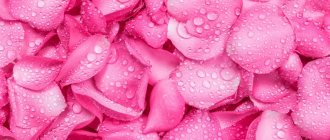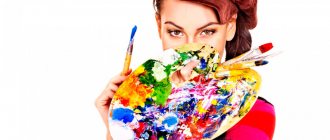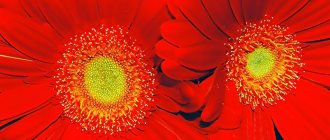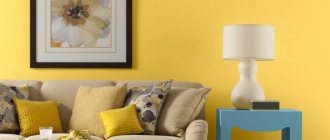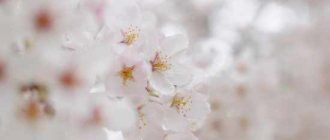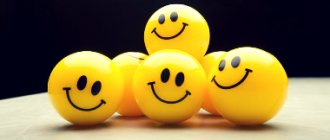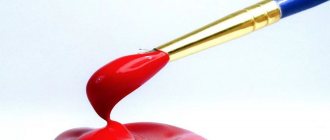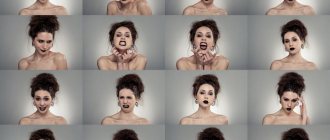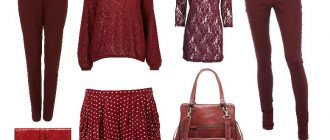Nastya Roshchinskaya, content marketer at SendPulse, wrote an article specifically for the Netology blog about how to evoke different emotions in email newsletter subscribers using color.
Colors are believed to influence human emotions and behavior. What does the right color do in email marketing? Helps lead the consumer to the target action and increase brand awareness. In this article I will tell you what associations different colors evoke and how well-known companies use this in their mailings.
Training program: “Email marketing: increasing sales and expanding our customer base”
What the Research Says
The perception of color depends on personal preferences, upbringing and cultural characteristics of a person, but when it comes to shopping and interaction with a brand, there are also universal points:
- for 80% of users, color affects brand recognition;
- 90% of customers decide to buy based only on the color of the product.
Color helps a brand stand out and be remembered from its competitors. It awakens memories and affects a person’s emotional state. And each in his own way. Let's figure out what email marketers can do about it.
The color green is associated with healing and relaxation
We hope that you remember that the color green creates harmony and promotes relaxation and tranquility in a person. So if your business specializes in healing, relaxation and tranquility, green will suit your logo better than any other color.
An interesting example in this case would be Starbucks. A well-known American chain specializing in the production and sale of coffee, instead of using the color red, which, as we found out, increases appetite, they put a rich green mermaid on their trademark, which evokes a feeling of warmth, calm and relaxation.
Thus, brand managers declare what kind of sensations their clients should experience when they come in during a break to drink a cup of aromatic coffee. Therefore, if your business is also interested in keeping your clients relaxed and calm, add some greenery to your logo and office design.
Yellow - we revive and lure
The sun and happiness are the first associations that come to mind. Rich yellow expresses joy, optimism and spiritual lightness, while darker shades are both calming and invigorating.
Yellow encourages impulsive shoppers, so use it in your flash sale or clearance emails. Add yellow if you want to cheer up your subscribers.
The Alice and Olivia newsletter is bright yellow, but it doesn't cause alarm or fear. On the contrary, the connection between the online store’s promotion and the legendary The Beatles and their hit Yellow Submarine comes to the surface:
The color red evokes a sense of urgency
We have already found out that the color red stimulates the senses and increases appetite, increases heart rate and raises blood pressure. It also creates a sense of urgency. It is for this reason that the color red is so often used in the logos of many famous brands. It is always present in sales announcements, it is successfully used by fast food restaurants, etc.
Minimum costs and profitability: is it worth opening an apartment renovation business?
Explore career opportunities: How to find your first job in a meaningful way
Secret stash for a rainy day: why everyone needs it and how to create it
This color is quite appropriate for novice businessmen who notify customers about the opening of a new store when announcing discounts.
Blue - we gain trust
The color of reliability. Tones and shades of blue are associated with safety and tranquility, instilling confidence and even increasing productivity.
Use blue in your newsletter to increase the company's credibility in the eyes of the subscriber, and blue to enhance the feeling of purity and peace. But dilute the color scheme of the letter with other shades so as not to inadvertently drive a person into depression.
The dermatological brand La Roche Posay cares about the health of girls’ skin, so the company’s logo and newsletters are made in rich blue colors, symbolizing purity.
Contrast and brightness
Brightness also plays an important role in the positive perception of your website. In general, it is believed that women prefer soft colors, while men prefer brighter ones. If we go back to the L'Oreal example, we can see that the colors in the photo are quite soft.
But at the same time, these colors would be inappropriate for a site that sells children's clothing: even if it is women who buy these clothes for their children, in this particular case they will pay attention to bright colors. This happens because children, first of all, are associated with cheerfulness.
Another significant factor that affects the readability of a website is contrast. Few people want to put in extra effort trying to figure out what is written on the form to fill out or anywhere else on the site. And you should absolutely not use an extremely bright or faded font for your main content! Imagine a black “Buy Now” button on a low-contrast background - most likely, the button will simply not be noticed.
The color scheme of your website affects its clarity and ease of use. Choosing inconspicuous colors when creating navigation bar buttons and drop-down menus is just as bad as having no menu or navigation bar at all. View your site from the user's point of view and you will understand what we are talking about. According to color psychology, orange, yellow, red, and blue are generally the best color options for these areas of a website.
Green - we encourage you to take care of nature
This color symbolizes nature, and nature is harmony, vitality and a new beginning. Dark shades are associated with wealth and stability, while light shades are associated with kindness and compassion.
Focus on green if the company's corporate policy is related to environmental friendliness. Tentree is an eco-friendly clothing brand. When the company reminds subscribers about the importance of protecting the environment, the emails are filled with rich colors of fresh greenery.
McDonald's logo: the secret to success
As you know, the main colors of the famous company’s logo are red and yellow. It was no coincidence that the team of professional marketers and designers chose them. This decision is explained by the fact that these warm tones are associated with stimulation and activity.
Equally important, red speeds up your heart rate, which increases your appetite, while yellow is associated with warm and happy days. In addition, this combination is clearly visible day and night, so the McDonald's sign is always visible.
Communicate with pleasant colleagues: how to maintain a positive atmosphere at work
Village medicine: why young doctors don’t want to work in the outback
The sooner the better: teaching children how to handle money (practical methods)
Purple - adds mystery, but not too much
Associated with luxury and secrets. The color purple motivates a person to solve pending tasks and problems, and most importantly, it evokes a desire to create.
Online clothing stores use light shades of purple to emphasize romance, while cosmetics brands convey mystery with darker shades. Try to use this color in moderation without distracting from the main thing, as NYX does.
Different shades can evoke different emotions
In the color spectrum, the upper region is reserved for warm tones, where red and orange are associated with warmth and optimism. Thus, red-orange logos radiate cheerfulness, passion and friendliness. On the opposite side of the color spectrum in logo design are sharper tones that can be classified as blue-purple. Colors such as blue, purple, and green are cool, and they tend to convey a feeling of calm, sophistication, and closeness to nature.
Black color - complement other colors
This color signifies sophistication, control and independence. Since black is the absence of any color, it correlates with secrecy, individuality and restraint.
Negative meanings of black include evil, sadness, depression and even death. So in your mailings, dilute it with other colors. Send intense black emails only to specific audiences or on special occasions. The Pull&Bear newsletter is dedicated to Black Friday and the chosen color corresponds to the occasion.
Black
Black is another very versatile color. It can be modern or traditional, exciting or relaxing. But if you use black as a contrasting color, that is, in a ratio of 1:6, 1:8 to the main one, you risk introducing drama and sadness into the perception of visual advertising materials by your clients.
Here is an example of a landing page well thought out in terms of colors - what do you associate these colors with? — https://cashflow-igra.ru
White color - balancing the elements of the letter
Traditionally it is associated with purity and innocence. White is a balanced combination of all the colors of the palette, so it can both charge you with vigor and optimism, and calm you down and drive away fears. But too much white can make people feel lonely and empty.
In newsletters, this color is most often used as a background, since it highlights the rest of the letter elements and matches all colors. Look at the newsletter from Cuyana - the white background gives a lightness, making the design look neat and restrained.
How to Use Color Psychology to Increase Conversions
To form an opinion about a product, the user only needs 90 seconds. The chosen color scheme plays a decisive role in the opinion of users. Color controls the emotions of visitors and determines their attitude towards the site and the brand as a whole. When you look at a color, your eyes communicate with a specific area of the brain known as the hypothalamus. It sends a signal to the pituitary gland to the endocrine system, and then to the thyroid gland. And the thyroid gland gives a signal to produce special hormones that affect mood, emotions and behavior. Neil Patel of QuickSprout says color accounts for 85% of the decision to purchase a product. Therefore, many companies invest a lot of money in research and creating selling packaging for their products. The same rule works for selling sites: use the right colors and you will always win.
In what elements should color be used?
Since color is everywhere, you should decide at the very beginning what color scheme to use. If you are making a selling website with a children's theme, then use green-yellow-red in the logo, phone number, menu, and headings. Your task is to evoke positive emotions in parents, which is why it is recommended to use more bright and saturated colors.
In order to choose the right color scheme, you should follow the following principles:
- the right color for the theme;
- the right color for the target audience;
- correct color depending on time;
- the correct color for each target action.
Here are some key tips on how professionals use color in their work.
Women don't like grey, orange and brown. They love blue, purple and green.
There are big differences between the color preferences of women and men. Neet Patel revealed which colors are preferred for each gender.
In a survey he conducted, 35% of women said blue was their favorite color, followed by purple (23%) and green (14%). 33% of women admitted that orange and brown are their least favorite colors; in addition, women also ranked gray as their least favorite (17%).
The results of this survey are very clearly confirmed by the WomansDay website; they use blue and purple on their home page.
There is a paradigm that women love the color pink. But that's not true. Only a small percentage of women chose pink as their favorite color. Therefore, it is recommended to use inserts of blue, purple and green colors in e-commerce sites. This will improve your site's appeal to women and increase conversions.
Men don't like purple, orange and brown. They prefer blue, green and black.
If you sell products for men, then do not use purple, orange and brown as the main colors of your site. This may turn off a potential buyer. Traditional colors for the male audience are blue and black. These are the colors that are associated with masculinity.
Use blue if you want to inspire trust among users.
Blue is the most common color. Not surprising, because it is the most preferred one for both men and women. Here are some other associations the color blue evokes:
- It is the color of trust, peace and order;
- Blue is the main corporate color in the USA (Intel, Dell, HP, IBM, etc.);
- It evokes feelings of calm and serenity.
The majority of the scientific community is inclined to believe that the color blue evokes trust and calm. And it’s no wonder why the largest social network in the world uses blue as its main color.
PayPal also prefers this color. This color scheme helps to inspire trust among users. If PayPal used red or orange as their main color, they would probably be less popular in the world.
Blue color is very often used by banks and credit organizations. For example, VTB24 uses it as the main color.
Despite the fact that blue is a very common color, it is under no circumstances recommended to use it when designing websites that relate to nutrition and food. Evolutionary theory suggests that the color blue is associated with poison. So never use blue if you are selling gourmet products.
Yellow is the color of warning.
The color yellow is used in warning signs, traffic lights and road markings.
It seems strange, because it is known that yellow is the color of happiness. Business Insider reports that "brands use yellow to show that they are interesting and friendly." According to this hypothesis, yellow evokes a feeling of playfulness. However, it is more likely that yellow stimulates arousal in the central part of the brain, and playfulness is simply a consequence of a state of heightened emotionality rather than pure joy.
The psychology of color is closely related to memory and experience. So, if you constantly wore a yellow shirt, lived in a house with yellow walls and ate at fast food centers with yellow arches, then the color yellow may cause joy in you due to its association with memorable events in your life.
Yellow can cause feelings of anxiety, so try to use yellow in small quantities as it can cause you to lose your clients.
Green is perfect for decoration.
Green is associated with nature, clean ecology and the environment.
If the theme of your site is related to nature (construction, air conditioning, etc.), then it is recommended to use green color to evoke in users an association with cleanliness and lightness. Green is the most common color to use in buttons. Thus, SpringSled, known for its strategy of attracting customers, uses green color in its design. Therefore, green is the ideal color for a call to action.
Using green will have a positive effect on the site and improve its reputation among those who are concerned about environmental issues.
Orange is fun.
The positive side of the color orange is that it can be used to evoke a cheerful mood. According to some reports, orange helps stimulate physical activity, competition and self-confidence. Maybe that's why orange is actively used by sports teams (for example, the Dutch national team) and in children's products.
Amazon uses orange for its Kindle page. Orange signifies relevance, making the message more noticeable and impactful.
Orange means pleasure and togetherness. Sometimes, orange is interpreted as "cheap". It is enough to compare orange with the color of luxury - black. Therefore, if you sell goods in a low price segment, it is recommended to use this color when designing website elements.
Black adds a sense of luxury.
The darker the background, the greater the lux.
An article from Lifescript describes black as "elegant, sophisticated, strong." That's why most high-end designers use black for e-commerce websites. Black is also described as “timeless, classic.” This helps explain the use of black in value-added products. Black can also be considered a luxury color. Black is also glamor, sophistication, exclusivity.
Just open the D&G website and everything will fall into place.
Black color is actively used by automakers. Here's an example of Lamborghini's website.
If you sell expensive luxury consumer goods, then be sure to use black in your website design to add special elegance and exclusivity.
Use bright colors for calls to action.
The most common colors for calls to action are: red, green, orange, yellow.
Darker colors like black, brown, or purple have low transition rates, unlike bright colors. Russian ebay uses red for pop-ups.
Aliexpress uses orange on the main buttons.
Orange is associated with “cheap”, but if you want to grab the attention of users, then use this color.
Don't neglect white.
Abundant use of white space is a powerful design element. Take, for example, the most popular website in the world.
Most well-designed websites today use white to create a feeling of freedom and lightness.
Conclusion.
If you use color in the right way, at the right time, for the right audience, and for the right purpose, you can achieve very high results. The more freedom you have with your color scheme, the better. Here are some tips to make your website better:
- Test colors
. You don't need to settle on one specific color. Test different color combinations to find out which color your target audience likes best. - Don’t force your designer into a “color box”
. When working with a designer, do not set strict conditions for him to use one color. - Follow the color scheme
. Don't forget that your goal is not to create a design that looks cool on the dribble. Beauty is of course good, but the main task of the site is to sell. Don't forget this. - Avoid color overload
. Don't try to use all colors at once in one design. This can lead to dire consequences. Too many colors can create a feeling of clutter.
Based on an article from the Kissmetrics blog. It was he who helped us develop sales page templates for LPCloud. How did color affect the conversion of your website?
Improve readability with color
Color can improve the clarity and readability of text by as much as 40 percent for two reasons:
- First, when developers strategically use color on each screen to enhance the clarity of content, they automatically make concepts more logical and aid reasoning and memory.
- Secondly, color can make content more readable. This is best achieved by creating eLearning course screens with contrasting chromatic text and background colors. Use the color wheel to find contrasting colors
Some tips for using color for better readability of content:
- The most legible of all color combinations are black on yellow and green on white, followed by red on white
- Black on white is easiest to read on paper and on a computer screen
- Hard colors (red, orange and yellow) are more noticeable and make objects appear larger and closer. It's easier to focus on them
- Soft colors (purple, blue and green) are less noticeable and make objects appear smaller and further away. They are not easy to focus on
Color and Conversion, or The Amazing Story of the Big Orange Button
The Big Orange Button has become a household name for the role of color in Conversion Rate Optimization (CRO). It is talked about with love and admiration on many blogs dedicated to CRO issues and practices. There are no clear explanations for this phenomenon, but let’s try to establish some possible reasons for this success of orange.
"Safety Orange" or burnt orange (Pantone color number 152) is used to highlight important information from the environment, especially in situations that require quick decisions and immediate attention, such as fast traffic, hunting, and natural disasters. This use of color is explained by the fact that the visual appeal of bright orange makes it stand out from any natural background: dark green forest, blue sky, dark blue ocean water.
The symbolic status of orange as a “safe color” makes it easier for visitors to make the decision to press the button, confident that nothing bad will happen to them.
Great news for web marketers, especially since the Big Orange Button works even better when it stands out like a hunter's safety vest in the woods—that is, the page needs to contrast with the CTA to make it grab users' attention. It might be worth testing a background of colors complementary to orange.
Blue color will inspire confidence and create a calm environment
If the main goal of your brand is the trust and confidence of your customers, then pay attention to the color blue. Even the walls of your office or store, painted in shades of blue, a website designed using it, a trademark, will undoubtedly benefit you.
In addition, we should not forget that blue color can increase productivity. Therefore, if your employees work in a blue room, then you will notice that their productivity will noticeably increase.
4. Improve learning and improve understanding
Because color connects neural pathways, people remember colors better than verbal or text cues alone. For example, the Color Matters Institute has confirmed that color can improve learning from 55 to 78 percent and improve learning quality by 73 percent.
OPEN AN ONLINE SCHOOL ON THE ANTI-TRAINING PLATFORM
Other studies have also shown that color images are remembered better than black and white ones. According to this data, most people surveyed could remember more images if they were in color than if they were in black and white.
To take advantage of this, eLearning designers must match the colors with the lesson material; for example, using color coding to enhance learning.
By using colored backgrounds on fact and concept displays, students can associate the color with the concepts and this will help them recall the information.
The influence of color on a person
Today, psychologists also study the problem of the influence of color on humans. From their point of view, certain shades carry emotional information and, therefore, participate in the formation of mood. Such data can be used to make your image more attractive, your environment more comfortable, and your products and services more salable. Colors can be used in the treatment of diseases of the nervous system, in marketing and other areas. Many people are skeptical about this. Indeed, such theories are difficult to study and cannot always be scientifically proven. However, they should not be completely rejected. Let's find out what they are, how colors influence a person and his life.
